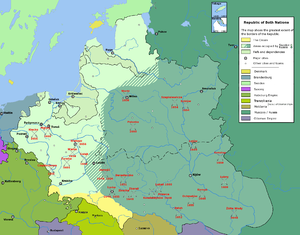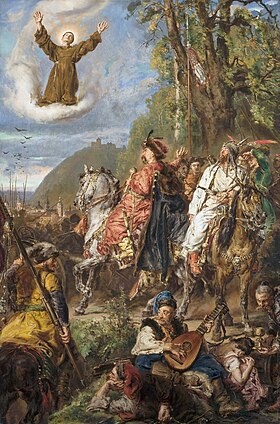do you know what happened to the Hadyach promoters? I will write and article about Briuhovetsky when I have time |
→Background: style |
||
| Line 24: | Line 24: | ||
== Background == |
== Background == |
||
For centuries after the creation of the Commonwealth, the [[Eastern Orthodox Church|Orthodox]] people of [[Ruthenia]] had felt oppressed by the Polish ''[[szlachta]]'', [[Catholic]] priests and [[Jew]]ish |
For centuries after the creation of the Commonwealth, the [[Eastern Orthodox Church|Orthodox]] people of [[Ruthenia]] had felt oppressed by the Polish ''[[szlachta]]'', [[Catholic]] priests and [[Jew]]ish "orendars" (arendators). Although [[Ruthenian]] [[nobility]] enjoyed full rights, they quickly absorbed [[Polish culture]] and therefore were alienated from the common people; the advent of the [[Counter-Reformation]] worsened the relationship between the [[Eastern Orthodox Church|Orthodox]] and [[Catholic church]]es. Unwilling to attend to the details of administration themselves, Polish [[magnate]]s often made [[Jew]]ish arendators their agents in managing their estates populated by mostly [[Ukrainian]][[peasants]]. The magnates sold and leased certain privileges to the [[Jew]]s for a rercentange of an estate's revenue ("rent") and, while enjoying themselves at their courts, left it to the Jewish leaseholders and collectors to become objects of hatred to the oppressed and long-suffering peasants. |
||
[[Image:Bohdan Chmielnicki z Tuhaj Bejem pod Lwowem Matejko.JPG|280px|left|thumb|" [[Bohdan Khmelnytskyi]] (left) with [[Toğay bey]] (right) at [[Lwów]]", oil on canvas by [[Jan Matejko]], 1885, National Museum in [[Warsaw]]. Khmelnytskyi Uprising 1648-1654.]] |
[[Image:Bohdan Chmielnicki z Tuhaj Bejem pod Lwowem Matejko.JPG|280px|left|thumb|" [[Bohdan Khmelnytskyi]] (left) with [[Toğay bey]] (right) at [[Lwów]]", oil on canvas by [[Jan Matejko]], 1885, National Museum in [[Warsaw]]. Khmelnytskyi Uprising 1648-1654.]] |
||
Revision as of 22:16, 23 November 2006
| Khmelnytsky Uprising | |||||
|---|---|---|---|---|---|
| Part of The Deluge | |||||
 Map showing the territories of the Republic controlled by Sweden, Muscovy, Brandenburg and Khmelnytskyi's Cossacks | |||||
| |||||
| Belligerents | |||||
| Cossacks | Poland-Lithuania | ||||
| Commanders and leaders | |||||
| Bohdan Khmelnytsky | Mikołaj Potocki, Jeremi Wiśniowiecki | ||||
Khmelnytsky Uprising (also Chmielnicki Uprising or Chmielnicki Rebellion) is the name of a civil war in the Polish-Lithuanian Commonwealth in the years 1648–1654. It was waged between the forces loyal to the Commonwealth and Ukrainian Cossacks led by Bohdan Khmelnytsky. In the end, the Commonwealth not only lost parts of its territory to Russia, but was weakened at the moment of invasion by Sweden: The Deluge.
Background
For centuries after the creation of the Commonwealth, the Orthodox people of Ruthenia had felt oppressed by the Polish szlachta, Catholic priests and Jewish "orendars" (arendators). Although Ruthenian nobility enjoyed full rights, they quickly absorbed Polish culture and therefore were alienated from the common people; the advent of the Counter-Reformation worsened the relationship between the Orthodox and Catholic churches. Unwilling to attend to the details of administration themselves, Polish magnates often made Jewish arendators their agents in managing their estates populated by mostly Ukrainianpeasants. The magnates sold and leased certain privileges to the Jews for a rercentange of an estate's revenue ("rent") and, while enjoying themselves at their courts, left it to the Jewish leaseholders and collectors to become objects of hatred to the oppressed and long-suffering peasants.

Khmelnytskyi's role
Although Khmelnytsky's personal resentment influenced his decision to rid Ukraine of Polish and Ruthenian magnates and Jews, it seems that his ambition to become the ruler of Ukraine was the main motive that led him to instigate an uprising of the Ruthenian people against them, known after him as the Khmelnytskyi Uprising.
Within a few months, almost all Polish nobles, officials, and priests had been wiped out or driven from Ukraine. Jewish losses were especially heavy because they were the most numerous and accessible representatives of the szlachta regime. Khmelnytsky told the people that the Poles had sold them as slaves "into the hands of the accursed Jews." With this as their battle-cry, the Cossacks massacred a huge number of Jews during the years 1648–1649. The precise number of dead may never be known, but estimates range from a minimum 50,000 to several hundred thousands Jews killed: 300 Jewish communities were totally destroyed. The Commonwealth population losses in the Uprising were over one million citizens killed. In reprisals, many thousands of Cossacks and peasantry supporting them were also murdered.
The uprising
These events initiated a series of campaigns (which coincided with the period in Polish history known as The Deluge, a Swedish invasion of the Commonwealth) that temporarily freed Ukraine from Polish domination but in short time subjected it to Russian domination. Successes at Zhovti Vody, Battle at Korsun and Battle at Pilavtsi (respectively, in Polish: Żółte Wody, Korsuń, and Piławce) against Hetman Mikołaj Potocki led to Khmelnytsky being paid off by the Polish king and gaining numerous privileges for the Cossacks under the Treaty of Zborov. When hostilities resumed, however, Khmelnytsky's forces were betrayed by their former allies the Crimean Tatars, suffered a massive defeat in 1651 at the Battle of Beresteczko, and were forced at Bila Tserkva (Biała Cerkiew) to accept a loser's treaty. A year later, the Cossacks had their revenge at the Battle of Batoh.
Jews and the Uprising
Historian Jacob Rader Marcus summarizes the situation as follows:
- "In 1654 neighboring Russia turned against Poland, a year later the Swedes poured in from the north, and all these groups, including the native Poles, ravaged and massacred defenseless Jewish victims throughout the land" (The Jew in the Medieval World, 1896).
The Eyewitness Chronicle detailes:
- "Wherever they found the szlachta, royal officials or Jews, they [Cossacks] killed them all, sparing neither women nor children. They pillaged the estates of the Jews and nobles, burned churches and killed their priests, leaving nothing whole." (Eyewitness Chronicle) [1]
The death tolls of the Khmelnytskyi uprising, as many others from the era of the Polish-Lithuanian Commonwealth, vary. Historian Orest Subtelny, in his acclaimed Ukraine: A History (p.127–128), notes:
- "Jewish losses were especially heavy because they were the most numerous and accessible representatives of the szlachta regime. Between 1648 and 1656, tens of thousands of Jews—given the lack of reliable data, it is impossible to establish more accurate figures—were killed by the rebels, and to this day the Khmelnytsky uprising is considered by Jews to be one of the most traumatic events in their history. Estimates of Jews killed in the uprising have been greatly exaggerated in the historiography of the event. According to B. Weinryb, the total of losses reported in Jewish sources is 2.4 million to 3.3 million deaths, clearly a fantastic figure. Weinryb cites the calculations of S. Ettinger indicating that about 50,000 Jews lived in the area where the uprising occurred. See B. Weinryb, "The Hebrew Chronicles on Bohdan Khmelnytsky and the Cossack-Polish War," Harvard Ukrainian Studies 1 (1977): 153-77. While many of them were killed, Jewish losses did not reach the hair-raising figures that are often associated with the uprising. In the words of Weinryb (The Jews of Poland, 193-4), "The fragmentary information of the period—and to a great extent information from subsequent years, including reports of recovery—clearly indicate that the catastrophe may have not been as great as has been assumed."
A study by Israeli demographer Shaul Stampfer (What Actually Happened to the Jews of Ukraine in 1648?, Jewish History, vol 17, 2003, pp165-178) concludes that 18,000-20,000 Jews were killed out of a total population of 40,000.
At the other extreme, some modern academic sources place the Jewish death toll in the hundreds of thousands. One source, The Jew in the Modern World (Oxford University Press), states that the uprising "left in its wake hundreds of thousands of Jewish dead, and, according to one witness, 744 Jewish communities destroyed." While the Jewish Encyclopedia considers the figure of 744 destroyed communities "unreliable," it views authoritatively "chronicles" which state that approximately 500,000 Jews were killed [2].
The aftermath
Weakened by wars, in 1654 Khmelnytsky persuaded the Cossacks to ally with the Russian tsar in the Treaty of Pereyaslav which led to the Russo-Polish War (1654-1667) and later, to incorporation of Ukraine into Muscovy. Although the Commonwealth tried to regain influence over Cossacks until late 17th century (of note is the Treaty of Hadiach of 1658), the new Cossack subjects became even more loyal to Muscovy. With the Commonwealth becoming increasingly weak, the Cossacks became more and more integrated into the Russian Empire, with their autonomy traded for state privileges. By the time partitions of Poland ended the existence of the Commonwealth in 1795, many Cossacks have already left Ukraine to colonise the Kuban.